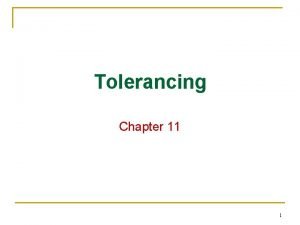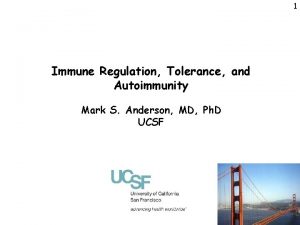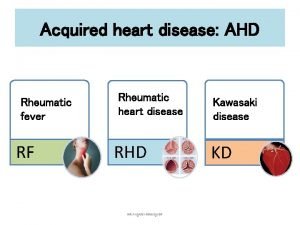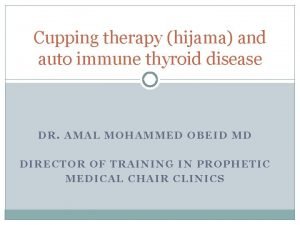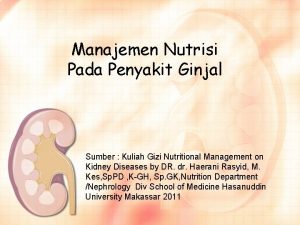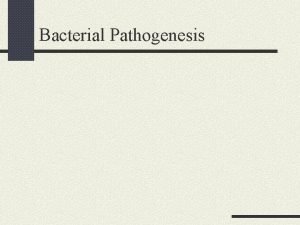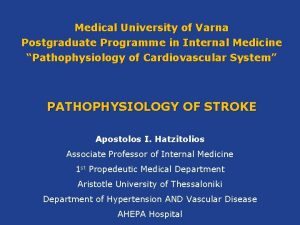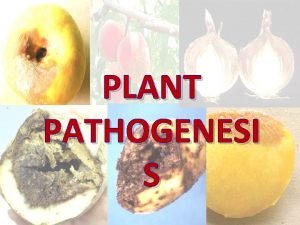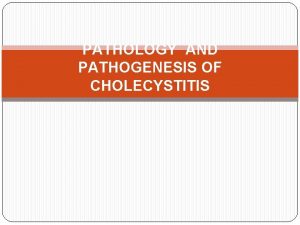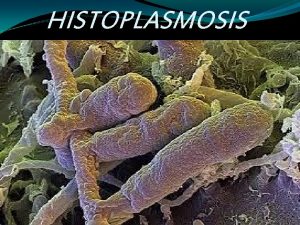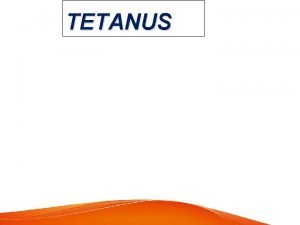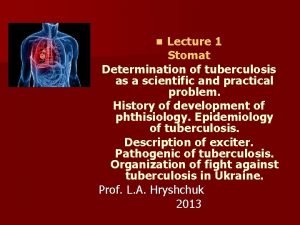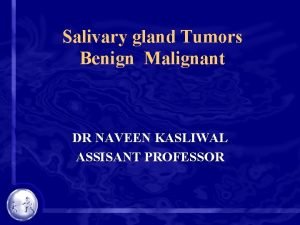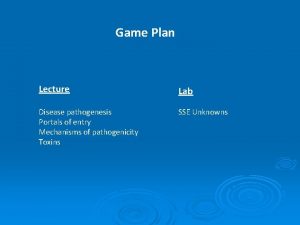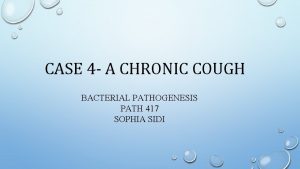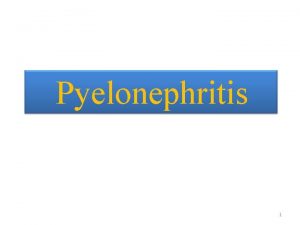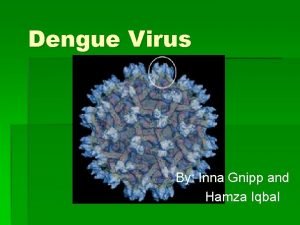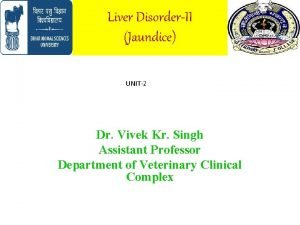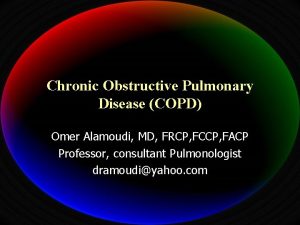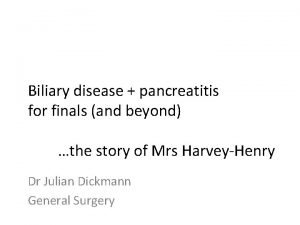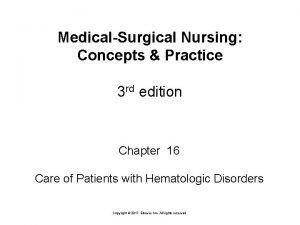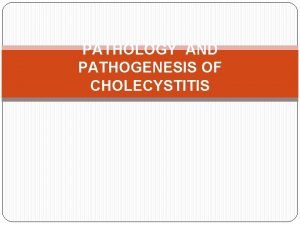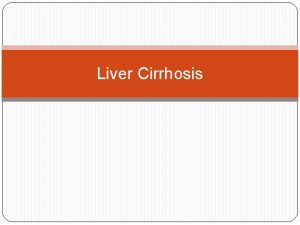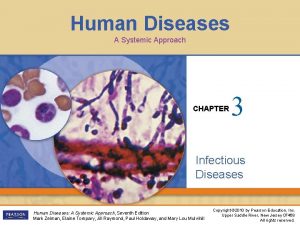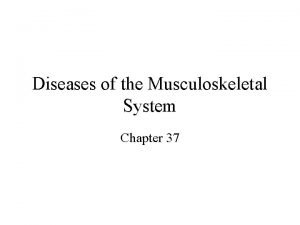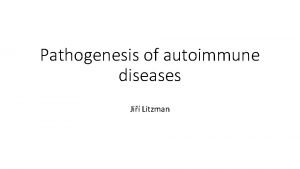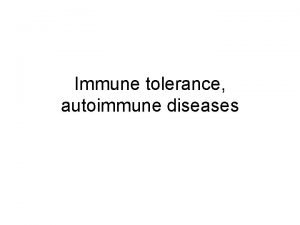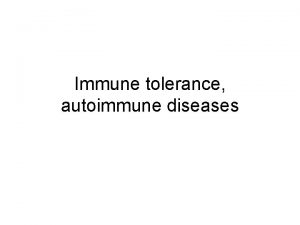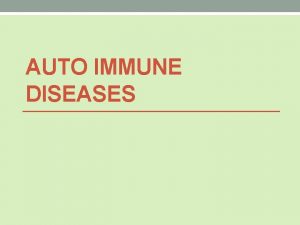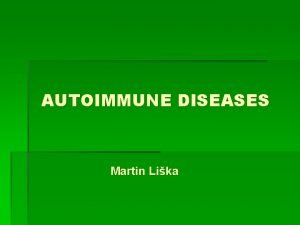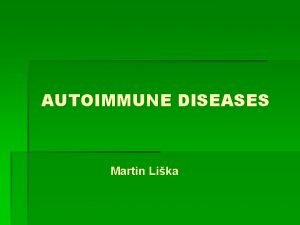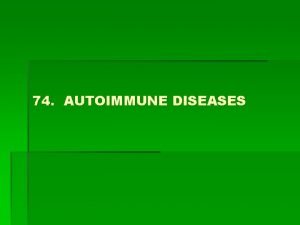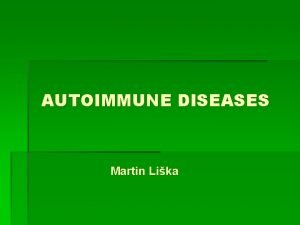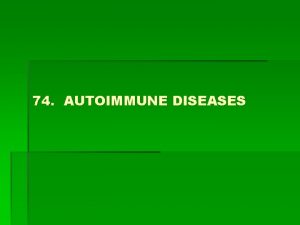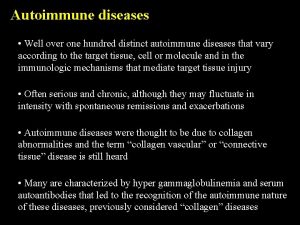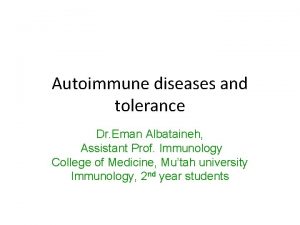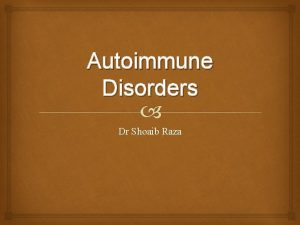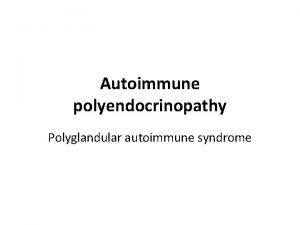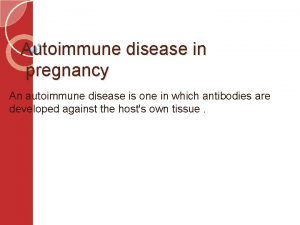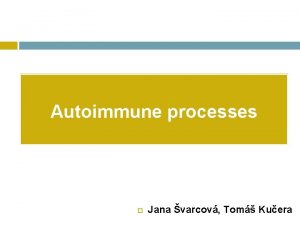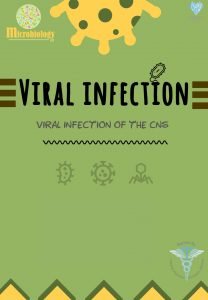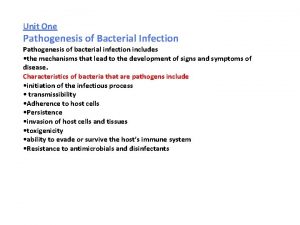Pathogenesis of autoimmune diseases Ji Litzman Immmune tolerance





























- Slides: 29

Pathogenesis of autoimmune diseases Jiří Litzman

Immmune tolerance

Clonal selection theory - Forbidden clones F. M. Burnet, 1957 • During (mainly fetal) development immunocompetent cells of the immune system develop. Each cell is characterized by its own antigen specific receptor. Each cell reacts only with one concrete specific antigen. • After exposure to autoantigen during fetal life autoreactive clones are eliminated ( „forbidden clones“). • If a concrete cell recognizes its specific antigen, it is stimulated, proliferates and forms a clone = clonal selection. • After repeated divisions the cell becomes a terminally differentiated cell, that does not proliferate and after some time dies. • The cells of the clone that do not differentiate into the terminal stage become a memory cells which will quickly react after the second exposure to the antigen.

Clonal selection theory Elimination of autoreactive clones Blood and periperal lymphatic organs Memory cells expansion antigen death Effector cells

Immune tolerance • Central • Peripheral

Central immune tolerance = clonal deletion • Negative selection during the thymic education proces. • Deletion of autoreactive B-lymphocytes in the bone marrow

Development of lymphocytes in the thymus

Thymic education • Positive selection: survival of cells reacting with low affinity to HLA antigens expressed on antigen-presenting cells in the thymus. Only those cells that recognize HLA antigen of the concrete person survive. The non-reacting cells die by neglect. • Negative selection – those thymocytes that react with high affinity with complexes of HLA-autoantigens in thymus die by apoptosis. • It is supposed that more than 90 -95% of thymocytes die during these processes.

Negative selection during thymic education • Negative selection – in the subcortical and mainly medullary areas of the thymus. Thymic epithelial cells in the subcortical and medullary areas of the thymus express a variety of somatic antigens on their HLA. • This expression is controlled by the gene AIRE. Apoptosis is induced in the thymocytes with high affinity with complexes of HLA-autoantigen. • It is estimated that during the processes of positive and negative selection up to 98% of the thymocytes are eliminated.

Strength of interaction between TCR and HLA-(antigen) complexes determines the fate of thymocytes Neglected cells Positive selectoion Negative selection Stength of interaction Cell death

AIRE gene deficiency • Results is a rare disease APECED (Autoimmune polyendocrinopathycandidiasis-ectodermal dystrophy) • Autoimune manifestations: autoimmune polyendokrinopathy (most importantly hypoparathyroidism, Addison's disease), autoimmune hepatitis, vitiligo, alopecia. . • Mucocutaneous kandidiasis is caused by autoantibodies against IL-17.

Innate defects of apoptosis • A number of genes may be affected. • The most frequent disease – autoimmune lymphoproliferative syndrome (ALPS). • Lymphadenopathy, hepatosplenomegaly, autoimmune anaemia, thrombocytopenia, other autoimmune diseases. • A significant increase of CD 4 -CD 8 -T-lymphocyte in the blood.

Immune tolerance • Peripheral: • Clonal deletion - elimination of autoreactive cells by apoptosis • Clonal anergy - costimulatory signals are lacking • Clonal ignorance - to low concentration of antigen does not stimulate immune response • Suppression - autoreactivity is blocked by regulatory cells

Activation of immune system by antigen B-cell receptor peptide Antigen B cell Antigen presenting cell DC 80/86 MHCII Interleukin 4, 5, 6 B-cell activation Interleukin 4 Antibodies Th 2 T Cell CD 28 Th 0 T Cell

Treg lymphocytes Thymic development, but can be induced also in periphery. FOX-P 3 is a crucial transcription factor In flow cytometry CD 4+CD 25+ (FOX-P 3+) Involved in tolerance of autoantigens Direct effect on other T cells by CTLA-4 molecule and also by soluble or membrane bound TGF-b. • Suppress function of antigen-presenting cells. • However also involved in „autotoleration“ of tumor cells • Comprise approximately 5 -10% of peripheral CD 4+ lymphocytes. • • •

FOX-P 3 transcription factor deficiency • Results is a serious rare disease - IPEX syndrome (Immune by the dysregulation, Polyendocrinopathy, Enteropathy, X-linked) • Severe autoimmune enteritis, diabetes mellitus, eczema, hypothyroidism. . . • The gene is on X-chromosome. • Lethal if haematopoietic cells are not transplanted.

Genetic aspects of autoimmune diseases • The accumulation of autoimmune diseases in families. • Inbred strains of animals which develop a defined autoimmune disease. • Association of autoimmune diseases with HLA antigens. • The significance of various polymorphism of cytokine/ cytokine receptors and other regulatory genes. • Failure of apoptosis leads to autoimmune diseases. • Majority of autoimmune diseases are more frequent in women.

Environmental factors in the development of autoimmune diseases • Infection • "Bystander" effect in the ongoing inflammation. • Molecular mimicry. • Polyclonal stimulation. Abnormal response to the physiological flora (IBD). Effect of UV light on the development and exacerbation of SLE The effect of stress is considered Several autoimmune diseases are more frequent in vaious geographical areas (the north-south gradient in multiple cerebrospinal sclerosis) • Increased intake of iodine is associated with more frequent occurrence of Hashiomoto thyroiditis. • •

Development of autoimmune disease after pregnancy • Suspected are hormonal changes after delivery and the termination of "immunosuppression" present during pregnancy.

Frequency of autimmune diseases (Mackay IR, BMJ 2000; 321: 93 -96) • It is estimated that approximately 5% (other estimations > 10%) of the population suffer from any autoimune disease. • Autoimmune impairment of the thyroid gland: approximately 3% of females. • Rheumatoid arthritis: 1% of the population. • Primary Sjogren's syndrome: 0. 6 -3% of women. • SLE: 0, 12% of the population. • Multiple sclerosis: 0. 1% of the population.

Autoreactitity and autoimmunity • Autoreactivity is a physiological process in which the immune system recognizes its own structure and respond to them. • It is involved during the growth, differentiation, removal of old cells. • Autoimmunity is a pathological condition, if there are clinical signs we speak about an autoimmune disease.

Pathogenesis of Autoimmune Diseases • Autoantibodies cause opsonization, activate the complement system, block/stimulate the receptors, may be involved in ADCC phenomenon. • Complexes with autoantigens cause immunocomplex diseases. • Autoreactive T-lymphocytes: cytotoxic but also Th lymphocytes are involved. The best-known example is multiple sclerosis, DM -I. • Non-specific mechanisms: chemotaxis of leukocytes to the site of inflammation.

Autoantibodies in pathogenesis of autoimmune diseases • The presence of various of autoantibodies in low titre can be observed quite frequently in many people not suffering from autoimmune diseases. • This incidence increases with age. • Quite often we encounter situation when diagnostically used autoantibodies are different from the autoantibodies of pathogenetic importance or cellular immunity plays a crucial role. • The finding of certain autoantibodies may precede autoimmune disease by many years ( antimitochondrial, anti-cyclic citrulinated peptides). • Autoimmune disease must have clinical symptoms, the presence of autoantibodies never provides a diagnosis of a disease!

Mechanisms leading to autoimmune diseases • Visualization of hidden antigens • Cross-reactivity of exo - and endoantigens (molecular mimicry) • "Bystander" activation • Abnormal expression of HLA-II antigens • Polyclonal stimulation of T-and B – lymphocytes • Impaired function of regulatory T-lymphocytes. • The formation of neoantigens (e. g. the effect of drugs, infections.

Hashimoto thyroiditis • Autoimmune thyroiditis • Lymphacytic infiltration of the gland • The presence of antibodies against thyroglobulin (TG) and microsomal peroxidase (MPO).

Hashimoto thyroiditis • Symptoms of hyperthyroidism can be observed at the beginning of the disease – perhaps as a result of release of hormones from the colloid due to the necrosis of follicular cells. • Sometimes, it is possible to demonstrate antibodies against TSHR, but they have usually a blocking effect. • On the contrary, in some patients with Graves - Basedow disease antibodies against TG and the MPO can be demonstrated.

Autoimmunity in Hashimoto thyroiditis • Antibodies against thyroglobulin and microsomal peroxidase - some fix complement, i. e. they can have a cytolytic effect, in another patients complement fixation cannot be demonstrated. • Some patients have antibodies against TSH – they have usually a blocking effect. • Pathogenetically, T-lymphocytes are probably the most important: Cytotoxic CD 8 lymphocytes, Th 1 lymphocytes stimulate both CD 8 lymphocytes ( IL-2, IFN-gamma), macrophages Th 2 lymphocytes stimulate formation of antibodies

Possible mechanisms leading to autoimmune thyroiditis • Molecular mimicry – the triggering antigen was not documented. • Now considered the possibility of cross-reactivity of HSP proteins. • Bystander effect of abnormal expression of HLA-II on the cells of the thyroid gland. • Induction of apoptosis – increased expression of FAS on thyreocytes under the influence of IL-1 beta (product of Th 1 cells)

Triggering factors of Hashimoto thyroiditis • Infection – quite frequently and infection precedes the disease, however a concrete triggering microbe has never been demonstrated. • Stress – can be documented in some patients • Sex – ratio of women: men - 25: 1 • A period after giving birth • A large intake of iodine radiation (mainly studies after the Chernobyl disaster)
 Unilateral tolerance and bilateral tolerance
Unilateral tolerance and bilateral tolerance Cellular and molecular immunology
Cellular and molecular immunology Beau's lines autoimmune disease
Beau's lines autoimmune disease Hijama for hypothyroidism
Hijama for hypothyroidism Autoimmune diet
Autoimmune diet Crohn's disease symptoms
Crohn's disease symptoms Bacterial pathogenesis
Bacterial pathogenesis Mechanism of ischemic stroke
Mechanism of ischemic stroke Appressorium diagram
Appressorium diagram Cholecystitis pathogenesis
Cholecystitis pathogenesis Histoplasma capsulatum pathogenesis
Histoplasma capsulatum pathogenesis Nursing management of neonatal tetanus
Nursing management of neonatal tetanus Pathogenesis of tuberculosis
Pathogenesis of tuberculosis Pathogenesis of pleomorphic adenoma
Pathogenesis of pleomorphic adenoma Baylor canvs
Baylor canvs Bacterial pathogenesis
Bacterial pathogenesis Nursing management of pyelonephritis
Nursing management of pyelonephritis Pathogenesis dengue fever
Pathogenesis dengue fever Jaundice pathogenesis
Jaundice pathogenesis Renal disease
Renal disease Left parasternal heave
Left parasternal heave Cholecystitis pathophysiology
Cholecystitis pathophysiology Pathophysiology of anemia diagram
Pathophysiology of anemia diagram Rabies pathogenesis
Rabies pathogenesis Cholecystitis pathophysiology
Cholecystitis pathophysiology Cirrhosis pathogenesis
Cirrhosis pathogenesis Milady chapter 8 skin disorders and diseases
Milady chapter 8 skin disorders and diseases Human diseases a systemic approach
Human diseases a systemic approach Diseases of the musculoskeletal system
Diseases of the musculoskeletal system Certain infectious and parasitic diseases
Certain infectious and parasitic diseases
